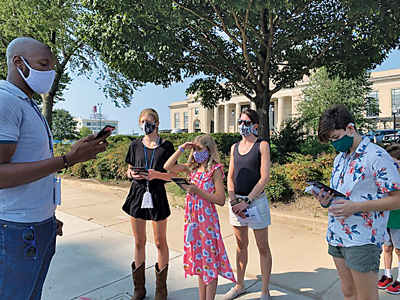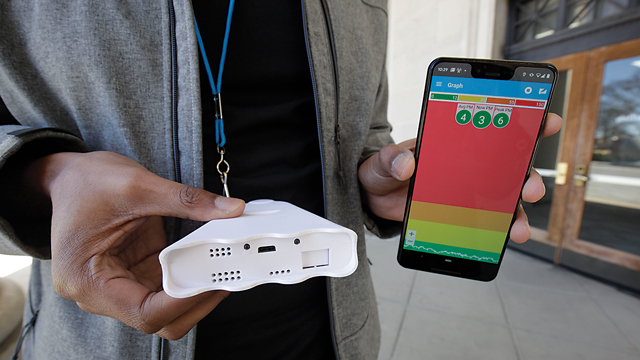Updated Tuesday, September 21
The Science Museum of Virginia will host two virtual town halls to discuss the results of the local air quality study. The events are scheduled for Wednesday, September 22 and Wednesday, September 29, from 6:30 to 7:30 p.m. If you participated as a citizen scientist, you’ll want to check this out. Registration is required and will close two hours before each meeting starts.
Community science is the best kind of science. Why? Because you don’t have to be a scientist to get involved, all ages can participate, and the information you collect helps the entire community.
Community science (closely related to citizen science) is a collaboration between scientists and public volunteers to gather new knowledge about the world. Community science can transform research and communities. For example, the American Geophysical Union’s community science program, Thriving Earth Exchange, has helped Ixchel (a grassroots organization that brings together West Side Chicago residents to address environmental justice) collaborate with a civil engineer to better understand extreme rainfall events and recurrent flooding in their community to improve civic governance around fixing the problems.
The Science Museum of Virginia has managed several community science projects, the most recent being a study of neighborhood air quality. The RVAir project, which is funded by the Institute of Museum and Library Services, offers opportunities for resident collaboration in measuring concentrations of airborne pollution in Richmond neighborhoods.
 How Does It Work?
How Does It Work?
Individuals and community partners measure local concentrations of airborne pollution known as particulate matter (PM), a mixture of microscopic particles in the air that have been linked with cardiovascular and respiratory diseases. The PM in smog and smoke can be generated from fireworks, grilling, vehicle exhaust, and fires, but most of the PM in our air comes from chemical reactions between sunlight and pollution from car traffic and power plants.
Special air quality sensors are used to gather the PM data. The devices measure pollutants in the air that we can’t see. The sensors don’t measure the exact type of PM, just the concentration (or the amount of PM within an amount of air) at a time and location.
RVAir community scientists use two methods to collect data: mobile and stationary. Stationary sensors are affixed at a location, such as a house or business. Using a standard power outlet and Wi-Fi, they transmit real-time data to an online database. Through the RVAir project, the Museum has installed more than thirty devices around Richmond, and the data being collected can be viewed at purpleair.com.
To collect mobile air quality readings, volunteers carry hand-held sensors on predetermined routes near the Museum and in their neighborhoods. There have been more than eighty mobile collection events, with more planned for the duration of the project.
What Are the Findings?
Before starting the RVAir project, studies in other cities showed that factors in the environment such as wide streets, traffic volume, close proximity to interstates and transportation hubs, housing density, and the number of trees lining streets significantly changed the amount of pollution in the air.
So far, preliminary findings in the RVAir project from both the hand-held sensors and stationary devices mirror the results from other studies. Blocks and neighborhoods with fewer trees, more vehicle usage, and more impervious surfaces had higher levels of PM than the areas of the city with more greenery and less traffic.
Why Does It Matter?
Air quality is something that affects all of us to varying degrees, both in the short and long term. Poor air quality can exacerbate allergy symptoms, aggravate asthma, inhibit lung function, and contribute to bronchitis and emphysema. Ambient air pollution accounts for an estimated 4.2 million deaths per year globally due to stroke, heart disease, lung cancer, and chronic respiratory diseases.
While the Virginia Department of Environmental Quality (DEQ) measures air quality just outside of the metro Richmond region, neighborhood-specific data is not available.
This DEQ data shows that, by and large, the Richmond area is enjoying the cleanest air it has had in decades, but even with that positive information, Richmond still consistently ranks near the top of the list as one of the sneeziest and wheeziest cities in the country, with asthma rates disproportionately higher in communities of color. Without more targeted data to help identify which parts of the city make citizens most sneezy and wheezy – and why – there is no way to know where to prioritize mitigation efforts.
Building a baseline understanding of hyperlocal air quality contributes to Richmond’s overall resilience to climate change. By leveraging the expertise of the community members to help get air quality data specific to streets and city blocks, citizens can collectively help create solutions that directly address the problems specific neighborhoods are facing.
RVAir provides a strong foundation for understanding climate change and its effects on our region and the communities within it by making topics like air quality more accessible for individuals and families alike.
A New Family Tradition
There are advantages to engaging with science as a family, including working activities into existing time together and experiencing the joy of learning alongside your kids. Participation in RVAir not only provides an opportunity for families to get involved together, but it also provides a real-time application of important science concepts children will use well into adulthood.
According to many who have participated already, learning about air quality is interesting for both parents and children and a great way to spend some time outdoors exploring Virginia’s capitol. Participating in RVAir also empowers families to see how the data can be used to advance better health outcomes and inform future decisions about the infrastructure and design of their neighborhoods. It creates a stronger connection to the community and helps families better understand what’s going on around them.
Seeing the PM numbers jump on the air quality sensor screen makes people more aware of what they and others around them are breathing in, and it gives participants a new perspective. As many families who have participated in RVAir have found, there is something special about discovering together and leaving a personal mark on both Richmond and science.
With collaborative community science projects like RVAir, area families get to be part of the magical journey of science to help collect important information that will have a positive lasting value.
The RVAir collection season is now open. Families interested in participating can go to RVAir and click the green button toward the bottom to see available dates and times.




